Krajanów
Krajanów [kraˈjanuf] (German: Krainsdorf) (Czech: Krajanov), is a village in the administrative district of Gmina Nowa Ruda, within Kłodzko County, Lower Silesian Voivodeship, in south-western Poland.[1] Partly due to its location along the border between Silesia and Bohemia, Krajanów has been a part of different states over its history.
Krajanów | |
|---|---|
Village | |
Saint George Church | |
 Krajanów | |
| Coordinates: 50°35′52″N 16°26′40″E | |
| Country | |
| Voivodeship | Lower Silesian |
| County | Kłodzko |
| Gmina | Nowa Ruda |
| Population | 160 |
Krajanów lies approximately 5 kilometres (3 mi) west of Nowa Ruda, 24 kilometres (15 mi) north-west of Kłodzko, and 73 kilometres (45 mi) south-west of the regional capital Wrocław. Abutting Krajanów across the border in the Czech Republic, is the village of Šonov in the Náchod District of the Hradec Králové Region, located immediately south of the village.
As of 2011, Krajanów had a population of 120.[2]
History
Beginnings
Thanks to its location along the border between Silesia and Bohemia, the vicinity of Krajanów has shifted between different states over time.
Although much of the Kłodzko Valley was likely under the rule of Great Moravia during the reign of King Svatopluk I in the late 9th century, the precise extent of his realm is disputed. Kłodzko castle, an important garrison on the road from Prague to Wrocław is noted to have been a possession of the Bohemian nobleman Slavník in 981 according to the Chronica Boëmorum, which was composed 2 centuries later in 1191 by Cosmas of Prague. Slavník notably, was the father of Saint Adalbert of Prague, the patron saint of Czechia, Poland and the Duchy of Prussia.
During the rivalry between the Přemyslid dukes Boleslaus III and Jaromir in 1003, the Polish king Bolesław I Chrobry invaded Bohemia, but had to pull back the next year, facing the forces of King Henry II of Germany. In turn the Bohemian duke Bretislaus I campaigned the adjacent northern territory of Silesia after Bolesław's death in 1025. An armistice mediated by Henry II, Holy Roman Emperor since 1014, demarcated the spheres of influence, leaving the area around Kłodzko with Bohemia.
When about 1080 the Polish Piast duke Władysław I Herman married Judith Přemyslovna, daughter of Duke Vratislaus II of Bohemia, he received Kłodzko as a Bohemian fief, which upon his death in 1102 was claimed by his son Duke Bolesław III Wrymouth of Poland. However, as Bolesław became entangled in a fierce inheritance conflict with Duke Svatopluk of Bohemia and his cousin Borivoj II and campaigned in the Bohemian lands several times, he finally had to renounce Kłodzko in favour of Duke Soběslav I of Bohemia in a peace treaty signed in 1137 under pressure from Emperor Lothair III.
The Free Judges
The first written record of the existence of Krajanów is from 1353. Exactly 70 years later in 1423, a Free Judge, a class of land owners specific to the County of Kladsko and belonged to the Third Estate, is noted to have lived in Krajanów. Descended mostly from German lokators, the Free Judges were people who had been granted special privileges by the King of Bohemia to reclaim and settle uninhabited areas. German law was gradually implemented in the Czech villages which predated their arrival. These municipalities were mostly located along the roads to Prague and Brno. The estate of a Free Judge was a separate legal entity with dominium rights. Such an estate would include not only agricultural lands and forests, but also mills, craft workshops as well as a pub, along with brewing and fishing rights. The subjects had to pay rent and provide certain services. An estate could be inherited by a child of either gender. When an estate was sold, the rights and privileges belonging to the estate were included in the sale. No taxes were levied on the estate itself, only on land added later.
County of Kladsko
While under Bohemian rule the area around Kłodzko became a county in 1458. In 1631 Krajanów was described as a large settlement with its own church.
Annexation to Prussia and the abolition of Kladsko County
In 1742 Kladsko County was conquered by Prussia, and Krajanów was annexed like the rest of Kladsko County. The village was quite active economically at the time, with records from 1748 indicating the presence of a water mill, 97 farms, as well as 21 craftsmen living in Krajanów. The county was abolished in 1816, and the territory was reformed into the Landkreis Glatz of Prussian Silesia.
Like neighboring Lower Silesia, the locals were subject to Germanization by the Prussian government over the following decades. Nonetheless, the village continued to prosper through the first half of the 19th century under Prussian rule. In 1840, Krajanów had 102 buildings, including: a church, a Catholic school, two farms as well as a water mill. There were also 57 cotton and 20 linen workshops, with a sizable number of locals engaged in the weaving industry. Although the village began to depopulate in the mid-nineteenth century, records show both a manor and an inn in Krajanów in 1870.
- Monuments and ruins in Krajanów
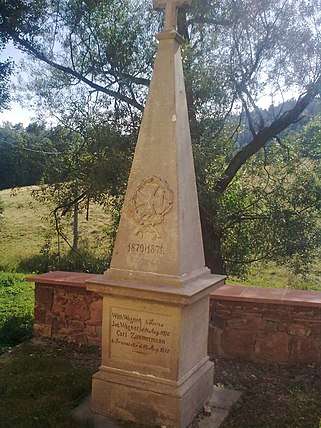 Inscription on a monument commemorating to those who lost their lives in the Franco-Prussian War
Inscription on a monument commemorating to those who lost their lives in the Franco-Prussian War Inscription on a monument commemorating to those who lost their lives in the Franco-Prussian War
Inscription on a monument commemorating to those who lost their lives in the Franco-Prussian War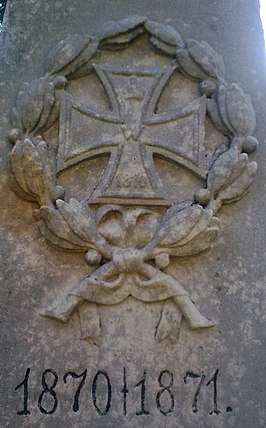 Cross on a monument commemorating to those who lost their lives in the Franco-Prussian War
Cross on a monument commemorating to those who lost their lives in the Franco-Prussian War
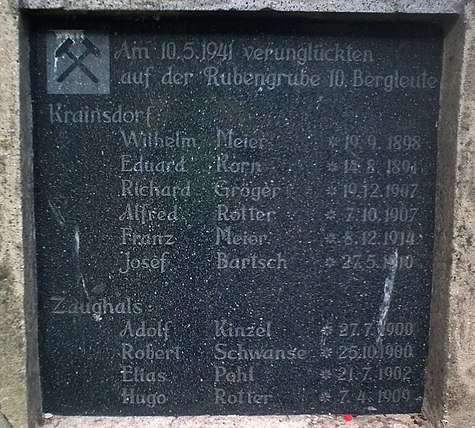 Monument dedicated to the victims of a mining accident
Monument dedicated to the victims of a mining accident Tower remnants in the ruins of a former manor
Tower remnants in the ruins of a former manor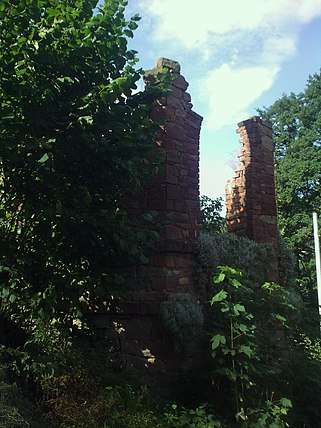 Tower remnants in the ruins of a former manor.
Tower remnants in the ruins of a former manor.
Claim by Czechoslovakia

After World War I the new Czechoslovak state laid claim to the County of Kladsko, which included the German village of Krainsdorf in the maximalist proposal put forth by the Czechoslovak delegation. All of their claims were however ultimately rejected by the 1919 Treaty of Versailles.
After 1945
After the capitulation of Nazi Germany in 1945, the town was placed under Polish administration according to the Potsdam Conference, and the area remains a part of Poland into the present day. The German inhabitants of the village were expelled. Czechoslovakia tried to annex the area in May of 1945, wanting to incorporate the Czech population which lived in the "Czech Corner" along the southern edges of the former County of Kladsko. A land swap between Poland and Czechoslovakia for Teschen Silesia was considered, but ultimately shelved. The Czechoslovakian Army had to cease military operations and withdrew from the area under pressure from the Soviet Union.
Whereas most of the former German and Czech settlements of Kladsko County were repopulated by Poles from regions east of the Curzon line as well as war-devastated central Poland, Krajanów was settled by a group of Górals. These Polish Highlanders from the Podhale region created a new home here as well as in the nearby villages of Czarny Bór and Borówno in Lower Silesia. While the new inhabitants initially cultivated their unique customs and folklore, these traditions have disappeared over time, and Krajanów is once again suffering depopulation.
At the edge of Broumovsko
Just south of Krajanów across the Czech border is the Broumovsko Protected Landscape Area. Named after the town of Broumov, the area is well known for its aesthetically and ecologically valuable landscapes. Broumovsko is noted for its extensive sandstone rock formations as well as a wealth of religious and folk architectural landmarks.[3][4]
For many centuries, the area was managed by Benedictine monks from their monastery in Broumov, thanks to whom a number of notable structures dating from the Baroque era can be found in the vicinity. [5] Walled manors and country estates of the Broumov type are also highly remarkable.[6]. The scenic Czech village of Martinkovice has a macabre past owing to a World War I prison camp where 2,600 mostly Serbian prisoners died of typhus and starvation. Many are buried at the WWI prisoner-of-war cemetery in Martinkovíce, which also has a cemetery of Soviet soldiers who were captured during World War II.
Home of Olga Tokarczuk
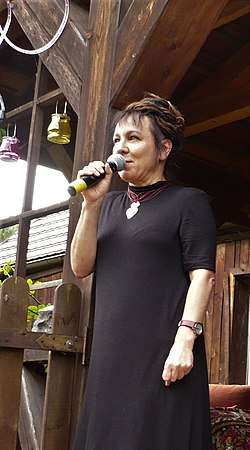
Although born in Sulechów near Zielona Góra, Nobel Prize laureate Olga Tokarczuk has lived in this village since 1998. Tokarczuk also manages her private publishing company Ruta in Krajanów.
The locale has influenced Tokarczuk's literary work[7]. Her novel Dom dzienny, dom nocny ("House of Day, House of Night", 1998) is a patchwork of loosely connected disparate stories, sketches, and essays about life past and present in the author's adopted home located in the Sudete Mountains in a multi-cultural borderland. While some have labeled it Tokarczuk's most "difficult" piece, at least for those unfamiliar with Central European history, it was her first book to be published in English.[8]
References
- "Central Statistical Office (GUS) – TERYT (National Register of Territorial Land Apportionment Journal)" (in Polish). 2008-06-01.
- "KRAJANÓW in Nowa Ruda (gm.w.) (Wałbrzych Subregion)". Retrieved 14 August 2020.
- "Broumovsko - touristic website - Nature". www.broumovsko.cz. Retrieved 2018-11-06.
- "Broumovsko Region, Adršpach-Teplice Rocks - Traseo.com - offline maps". traseo.com. Retrieved 2018-12-04.
- "Churches of the Broumov region". Broumov Monastery. Retrieved 2018-12-04.
- "The Broumovsko Protected Landscape Area Twenty Years Old". Ochrana přírody. Retrieved 2018-12-04.
- "Sąsiedzi Olgi Tokarczuk: Jesteśmy dumni". Fakt 24. Retrieved 1 May 2020.
- Neale, Alison, ed. (2003). International Who's Who of Authors and Writers 2004. Europa Publications. p. 545. ISBN 978-1-85743-179-7.